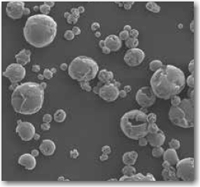Restructured salt reduces sodium content; Understanding food’s effect on the brain
CUTTING EDGE TECHNOLOGY
Restructured salt reduces sodium content
 Due to pressure from government agencies and consumer groups, the food industry is removing some salt from its products. However, reducing the salt content is not a simple task. Thankfully, food formulators have many options at their disposal.
Due to pressure from government agencies and consumer groups, the food industry is removing some salt from its products. However, reducing the salt content is not a simple task. Thankfully, food formulators have many options at their disposal.
One of the latest options is SODA-LO™ salt microspheres from Tate & Lyle, Hoffman Estates, Ill. The product enables food makers to reduce salt levels 25–50%, depending on the application. Its salt-reducing properties are due to its structure—a hollow crystalline microsphere that delivers salty taste by maximizing surface area relative to volume. The free-flowing product is made using a patent-pending spray drying technology.
The product is best suited for topical applications and other applications with some fat in the formulation such as bread, cheese, and meat or applications in which water is immobilized by inherent solids, added starches, or other hydrocolloids. It is not designed for liquid or beverage applications where it can dissolve and lose its structural advantages. Tate & Lyle testing shows that consumers perceive taste parity between products made with regular salt and foods containing the salt microspheres.
SODA-LO salt microspheres are available in two varieties: Extra Fine and Fine. Extra Fine is about 20 microns in size (for comparison, table salt is about 500 microns). It can be labeled as “salt” or “sodium chloride” when less than 1.5% is used in the final food product.” The small particle size enables more uniform distribution in bread, resulting in improved salt functionality at reduced levels. Fine is about 200 microns in size and can be labeled as “salt” or “sodium chloride.” Its proximity in size to table salt makes it particularly well-suited for topical applications. Both Extra Fine and Fine products have a 2-year shelf life.
Understanding food’s effect on the brain
 A new public-private partnership has been established to develop innovative new technology for the measurement of visual product perception, product choice, and eating behavior. Called FOCOM, which is short for Food and Cognition Model systems, the project taps the scientific and technical expertise of three Dutch universities, four high-tech companies, a large multinational food company, and two food research firms.
A new public-private partnership has been established to develop innovative new technology for the measurement of visual product perception, product choice, and eating behavior. Called FOCOM, which is short for Food and Cognition Model systems, the project taps the scientific and technical expertise of three Dutch universities, four high-tech companies, a large multinational food company, and two food research firms.
The goal of FOCOM is to design novel tests that can assist in the understanding of how food and the brain influence each other. One of these is a “virtual shop simulator,” which allows a consumer to navigate through a virtual supermarket while his behavior, physiology, and brain responses are captured. A translation will be made from a clinical fMRI (functional magnetic resonance imaging) environment to a more consumer-friendly test environment in which eye movement and brain responses such as EEG and NIRS (near-infrared spectrography) can be measured. The technique will be used to investigate why consumers like or dislike certain products, and how the choice and purchase process works. Special attention will be paid to the influence of the design of product packaging on choice behavior.
FOCOM will also address what happens in the brain during eating. Which ingredients contribute to a positive experience of a food product? Does a low-energy or low-salt product lead to the same satisfaction? By observing what happens inside the brain, when seeing or eating food, the researchers hope to learn about what contributes to the food-related pleasure. This knowledge may then be used for the development of a new generation of nutritional products that contribute to a balanced and healthy diet.
Knowledge of these factors may also help food companies to better understand the effect of product attributes at an early stage of product development. This knowledge may enhance the product development process, reduce development costs, and shorten time to market. Furthermore, the new technology may support early diagnosis and a better understanding and treatment of obesity, eating disorders, and age-related diseases such as Alzheimer’s and Parkinson.
